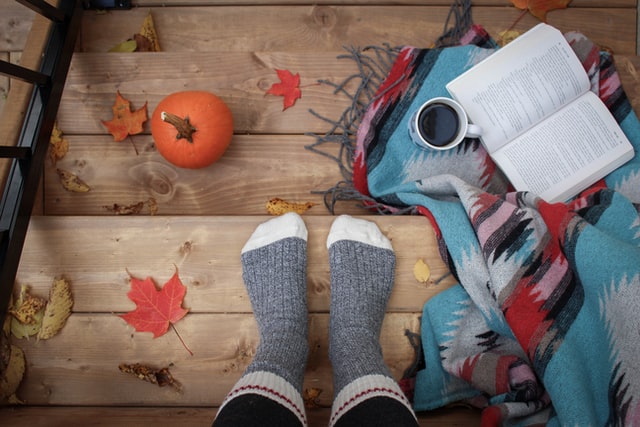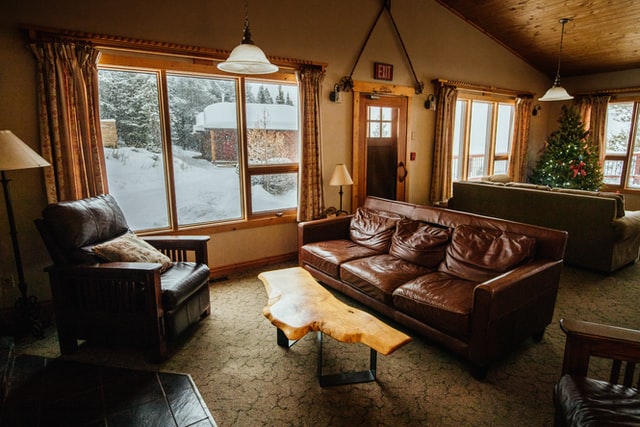Highly recommended, we show how you can protect your home from the too cold with little effort. Give tips on heating and ventilation and. Reveal how to prepare yourself for cooler temperatures properly.
So that you can enjoy the cold season at home:
Contents
Dress up your home for winter
Fabrics, textiles, and carpets are good accomplices for frosty days and nights.
They keep the warmth in and the cold out. And make the apartment appear cozier and livelier.
Here are a few ideas for your winter apartment outfit:
. Hang thicker curtains in front of windows and doors as protection against the cold – and close them at dusk at the latest
. Cover up your walls – it doesn’t have to be the tapestry, shelves with books or a simple curtain also insulate from the outside
. Hang a canopy over your bed – this way; you’re sleeping place will cool down less
. Put rugs on cold tiles and bare wood floors – even in the bathroom.
Put the seats and beds back in a warm place.
Rooms are never the same warm everywhere.
If you freeze quickly at home, you can therefore try moving your furniture in winter.
As a rule of thumb, avoid outside walls.
Although masonry keeps out the cold better than windows or doors, interior walls are always warmer – in poorly insulated houses, even up to a few degrees.
The desk by the window may offer the best view – but it is warmer that you sit on an inside wall. The same goes for the head of the bed.
And when you are at the back of the furniture: Tightening up the furniture also generates warmth. Just away from the wall, closer together, preferably near a fireplace or heater, of course.
Let the sun in
The sun heats rooms, even in winter.
When the sun is shining, remove curtains and other items from the south and west windows and let sunlight and warmth into the house.
Thanks to the sun, the apartment becomes warmer – and you use the sunlight to boost your happiness hormones.

Lockout drafts cold usually comes into the house as a draft.
To keep drafts out, close open spaces wherever possible.
A first check is worthwhile with the doors and windows:
To find cracks and leaks, use a tea light to slowly trace the contours of the inside of your window frames on a windy day. Drafts penetrate where the flame flickers.
You can fix such leaks for little money with simple seals from the hardware store.
Openings where drafts cannot be avoided entirely – such as with a letter slot or the cat door – can be protected with a curtain.
Check the heating hardware.
A warm home needs intact radiators.
Bubbling or ticking noises in the radiators are a sign that something is wrong.
The good news: Many radiator problems can be quickly resolved yourself or fixed by a professional:
. The heater is ticking or bubbling – there are usually air bubbles in the pipe; simple venting helps
. The heating does not get warm – air could be the problem here too, venting it as well
. Radiator stays cold – defective or blocked valve
. The radiator is only lukewarm despite turning it on – watch, if necessary, call in a plumber.
Heat all rooms sufficiently.
Pleasant warmth is created when you heat enough and do not let the rooms cool down. As a guideline, the outer wall’s inside should always be more than 15 to 17 degrees.
You should, therefore, always run the radiators on at least a low level – even at night or when you are not there for a short time. And also in rooms that you use little or not at all
Why?
Because rooms that are too cold prevent adjoining rooms from getting warm, a strongly cooled room needs more time and energy to get cozy and warm water.
Ventilate properly
Anyone who heats must also ventilate.
Because ventilation protects rooms from excessive humidity and mold
And this is how you ventilate properly in winter:
. Above all, ventilate where there is a lot of moisture – i.e., where people are where laundry is drying, or pots are steaming
. Open the windows wide for a few minutes so that the air can exchange easily
. Do not leave the windows tilted permanently; otherwise, the walls will cool down, and mold may develop
. The colder it is outside, the shorter you can ventilate because the air exchange is faster
. Switch heating thermostats to “Frost” or “Zero” while ventilating. Otherwise, it will heat up too much afterward
Clear. Heat is always lost when air is exchanged. But if you ventilate correctly, you will have enough warmth in the room shortly after closing the windows. And a healthier climate.
Use additional heat sources.
Additional heat sources, such as a fireplace or a towel radiator for the bathroom, are, of course, ingenious to keep the apartment nice and warm.
But other things in the household also give off heat that you can use for your comfort.
Two ideas:
. The oven – warms up food and releases residual heat into the kitchen after it has been cooked
. The bathtub – first warms you with warm water and then releases steam into the room air.
Dress up warmer
Indeed, the easiest of all methods for a warmer home is warmer clothing.
Above all: warm socks.
Because our body always warms our organs first when it is cold – which is why hands and feet are always the first to freeze? Counteract this by packing your feet well at home.
But otherwise, warm clothing and cozy bed linen are an excellent idea to stay warm at home.
It’s winter, after all.
Get your body used to the cold.
Nobody likes to freeze.
But cold is part of it in winter – and a body that is prepared for it can cope better with a more comfortable apartment.
Our tips:
. Go out, preferably every day; it doesn’t have to belong either
. Do not turn up the heating too much in the office or the car
. Move. Walking, biking or skiing are suitable for your mood, bones, and body temperature
The effect, your body, tolerates the cold better, and you feel more comfortable even in low temperatures.
Also, the contrast to the outside makes the apartment appear much warmer.
And then…
Snuggle up together
Two bodies are warmer than one.
Probably the best way to feel warmer at home is to snuggle up together. You probably already know with whom…
We wish you a lot of fun and cozy winter!







